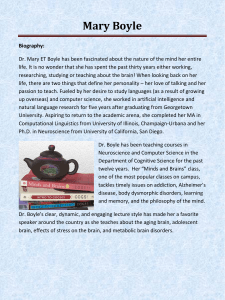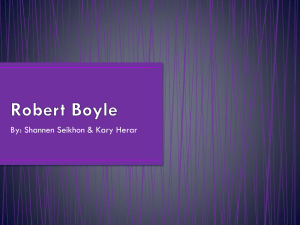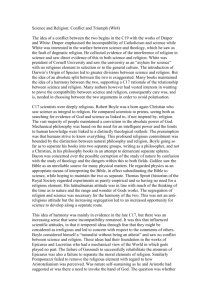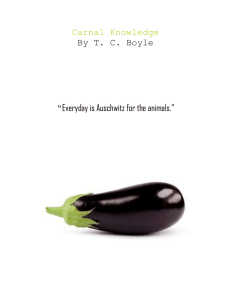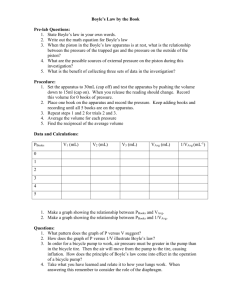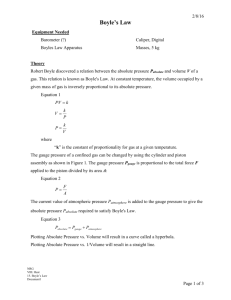Gleason Book
advertisement
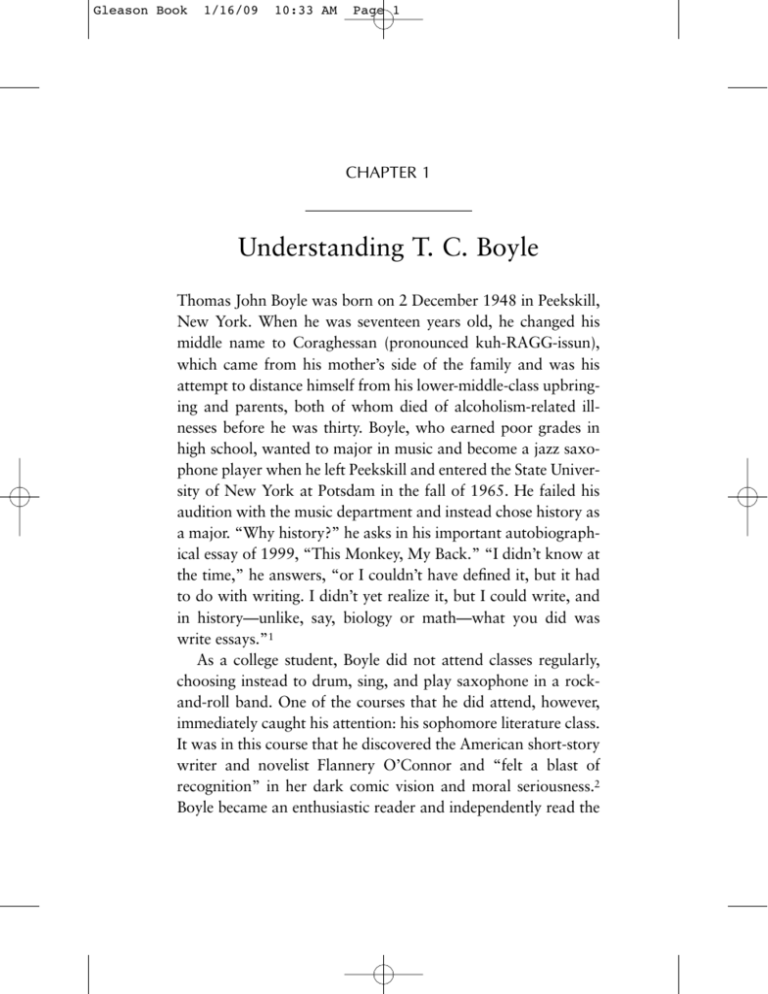
Gleason Book 1/16/09 10:33 AM Page 1 CHAPTER 1 Understanding T. C. Boyle Thomas John Boyle was born on 2 December 1948 in Peekskill, New York. When he was seventeen years old, he changed his middle name to Coraghessan (pronounced kuh-RAGG-issun), which came from his mother’s side of the family and was his attempt to distance himself from his lower-middle-class upbringing and parents, both of whom died of alcoholism-related illnesses before he was thirty. Boyle, who earned poor grades in high school, wanted to major in music and become a jazz saxophone player when he left Peekskill and entered the State University of New York at Potsdam in the fall of 1965. He failed his audition with the music department and instead chose history as a major. “Why history?” he asks in his important autobiographical essay of 1999, “This Monkey, My Back.” “I didn’t know at the time,” he answers, “or I couldn’t have defined it, but it had to do with writing. I didn’t yet realize it, but I could write, and in history—unlike, say, biology or math—what you did was write essays.”1 As a college student, Boyle did not attend classes regularly, choosing instead to drum, sing, and play saxophone in a rockand-roll band. One of the courses that he did attend, however, immediately caught his attention: his sophomore literature class. It was in this course that he discovered the American short-story writer and novelist Flannery O’Connor and “felt a blast of recognition” in her dark comic vision and moral seriousness.2 Boyle became an enthusiastic reader and independently read the Gleason Book 1/16/09 10:33 AM Page 2 2 / Understanding T. C. Boyle works of some of the twentieth century’s greatest writers, including John Updike, Saul Bellow, Albert Camus, and Samuel Beckett. The works of Beckett and other absurdist writers, which he eventually read as a student in a creative writing workshop offered by Professor Krishna Vaid, particularly affected him “because it was readily apparent that their authors were wise guys just like [him]—albeit very sophisticated, very nasty, and very funny wise guys.”3 Inspired by these writers, Boyle wrote his first creative piece for Professor Vaid’s class, a comic one-act play called The Foot, in which a husband and wife mourn the death of their child, whom an alligator has devoured. When Boyle read the play aloud in class, he experienced his first public triumph as a writer. After hearing the play, Professor Vaid “began to smile and then to grin and chuckle and finally to laugh without constraint.” Professor Vaid and Boyle’s fellow students applauded after the reading was finished, and Boyle experienced “the sort of exhilaration that only comes from driving the ball over the net and directly into your opponent’s face.”4 Boyle eventually graduated from SUNY Potsdam in 1968 with degrees in English and history and shortly thereafter took a job as a highschool English teacher in Peekskill, a position he held to avoid the Vietnam draft until he entered graduate school at the University of Iowa in 1972. Boyle’s college experience and first reading encapsulate what would eventually become the central aesthetic of his fiction, as well as his understanding of the social role of the fiction writer. Fiction, according to Boyle, should be cynical and funny, performative and strange, but, above all, entertaining and fun. In addition, as his famous public readings and the regularly updated blog at his official Web site demonstrate, Boyle thinks that the Gleason Book 1/16/09 10:33 AM Page 3 Understanding T. C. Boyle / 3 fiction writer should be a performer and an entertainer who regularly interacts with his audience in public. As a former history major, Boyle also posits that the fiction writer’s texts should contextualize his characters in specific eras of American history and use satire as a moral force for the improvement of society. But as Boyle writes in “This Monkey, My Back,” his central identity as a fiction writer, the one that informs every word that he writes, is that of the wise guy—that is, the intelligent, funny, and, perhaps even, arrogant and disrespectful smart aleck who makes readers laugh even as he or she teaches them a lesson. This concept of the fiction writer as wise guy derives in part from Boyle’s reading of absurdist writers such as Beckett but also from his formative engagement with great American postmodernist novelists, particularly John Barth, Thomas Pynchon, and Robert Coover. When Boyle was an undergraduate in the late 1960s and a graduate student in the 1970s, Barth, Pynchon, and Coover were publishing their most experimental, influential, encyclopedic, erudite, and, many readers would argue, difficult works. In particular, four of their novels—Barth’s The Sot-Weed Factor (1960), Pynchon’s V. (1963) and Gravity’s Rainbow (1973), and Coover’s The Public Burning (1977)—inventively combine historical fact and fiction to satirize specific events in American history. Barth, Pynchon, and Coover are famous wise guys who poke fun at American mythology, politics, and institutions in their long, difficult, and ambitious historical novels. In his fiction Boyle retains their comic spirit and interest in history but makes his work more accessible and entertaining to his readers. Unlike the difficult canonical modernist writers of the first half of the twentieth century—for example, James Joyce, Marcel Proust, Gleason Book 1/16/09 10:33 AM Page 4 4 / Understanding T. C. Boyle William Faulkner, and Virginia Woolf—and the equally difficult postmodernist writers who followed them in the second half of the twentieth century—Barth, Pynchon, and Coover, of course, but also William Gaddis, William H. Gass, William S. Burroughs, and Joseph McElroy—Boyle constructs plots and characters that are weird but accessible, thought provoking but immediate. In addition, unlike some of the major works of twentieth-century modernist and postmodernist fiction, Boyle’s fiction is earnest, using its comedy to provide clear moral messages at the expense of modernist ironic detachment and postmodernist nihilistic humor. Boyle’s interest in writing funny, entertaining, and moral fiction also derives from his reading of another group of writers when he was in the graduate program at the University of Iowa. Deciding to pursue a Ph.D. in English literature, Boyle specialized in British literature of the Victorian period. This meant that just as he was reading the novels of Barth, Pynchon, and Coover, he was also reading the didactic, popular, and moralizing novels of George Eliot, Thomas Hardy, Charlotte and Emily Brontë, Anthony Trollope, William Makepeace Thackeray, and, above all, Charles Dickens. Dickens influences Boyle’s conception of himself as a socially engaged, entertaining, popular, and prolific writer of fiction. In an interview conducted in 1988 (but not published until 1991), Boyle told Elizabeth Adams that he admires Dickens for being “a quintessential artist, one who was a very popular author, and who also wrote brilliantly and well and originally.”5 In a 2000 interview with Judith Handschuh, Boyle acknowledged the Dickens connection to his own work: “Critics and reviewers have compared me with Dickens, and I take that as a compliment . . . I look to writers like Dickens . . . for inspiration.”6 Gleason Book 1/16/09 10:33 AM Page 5 Understanding T. C. Boyle / 5 Boyle learned from Dickens to entertain his readers with dark humor, strange plots, and even stranger characters. Dickens also taught Boyle to use comedy to provide readers with a moral education. The reader’s laughter and anger at the ineffective legal and government systems of Bleak House and Little Dorrit result in a feeling of compassion for the downtrodden and poor, whose happiness and well-being are harmed by those systems. In addition Dickens, who was an actor and spent his last years giving public readings of his most famous works, exemplifies for Boyle the importance of the writer’s role as a public figure, as well as his willingness to reach his readers through public appearances. In the Adams interview, Boyle said, “You have to envy [Dickens] his readings, his famous readings. He was the Mick Jagger and all entertainment of his day wrapped up in one.”7 Finally Boyle and Dickens are both highly prolific writers. By the time he turned fifty-eight at the end of 2006, Boyle had published eleven novels and more than one hundred and fifty short stories. When Boyle was reading postmodern and Victorian fiction at the University of Iowa, he was also attending the university’s Writers’ Workshop, where he studied with the important American writers John Irving, Raymond Carver, and John Cheever. Carver and Cheever had a particular—and surprising—impact on Boyle. One of the most important practitioners of literary minimalism, a movement that is characterized by an economic deployment of words and a focus on surface description, Carver inspired Boyle as a graduate student to abandon temporarily the encyclopedic aesthetic of Barth and Pynchon to concentrate on short fiction, a decision that eventually led to the publication of Boyle’s first collection of stories, Descent of Man, in 1979. This collection disciplined Boyle to condense his dark comic vision and verbal pyrotechnics to the space of individual short stories. Gleason Book 1/16/09 10:33 AM Page 6 6 / Understanding T. C. Boyle Cheever, on the other hand, provided Boyle with necessary advice. In “This Monkey, My Back,” Boyle remembers that Cheever “couldn’t make any sense out of The Sot-Weed Factor and didn’t see that it was worth the effort trying.” Cheever taught Boyle that “all good fiction is experimental . . . and don’t get caught up in fads.”8 Boyle learned from Cheever to harness his experimental impulses and love of postmodern fiction and write texts that appeal to a large audience through an emphasis on plot and character. After submitting the Descent of Man collection as his creative dissertation in 1977, Boyle graduated from the University of Iowa with a Ph.D. in Victorian literature. In 1978 he accepted an assistant professorship in the English department of the University of Southern California, where he has taught ever since. The best way to read the work of this self-professed wise guy is to remember its origins in the mind of a man who came of age in the tumultuous decade of the 1960s. Like many members of his generation, T. C. Boyle (he stopped using Coraghessan on his book covers when he published an omnibus collection of his short stories, T. C. Boyle Stories, in 1998) as a young man resisted the authority of the establishment, experimented with drugs, rock music, avant-garde literature, and radical ideas, and avoided the Vietnam draft. Some of Boyle’s best and best-known fiction—the short story “Greasy Lake” (1981) and the novels World’s End (1987), The Tortilla Curtain (1995), and Drop City (2003)—explore his generation from many perspectives, always searching for the motivations for idealism in individual lives and the results of this idealism on American society and history. Elsewhere in his fiction, Boyle extends his analysis of idealism to other eras of American history. The Road to Wellville (1993) Gleason Book 1/16/09 10:33 AM Page 7 Understanding T. C. Boyle / 7 and The Inner Circle (2004) combine fact and fiction in their explorations of the lives of historical American reformers who have a passionate commitment to changing society for the better and who obsessively and irrationally pursue their quests. The Road to Wellville examines Dr. John Harvey Kellogg’s attempts at the beginning of the twentieth century to change the eating and exercising habits of Americans in an effort to extend their life spans, presenting the megalomania and fanaticism that existed alongside Kellogg’s idealism. The Inner Circle, Boyle’s novel on the activities of the sex researcher Dr. Alfred Kinsey in the 1930s through the 1950s, works the same thematic territory as The Road to Wellville, simultaneously admiring Kinsey for the openness that he brought to American sexuality and deploring him for the harm that his sexual theories caused his family and the members of his research team. In these two historical novels, Boyle concludes that hypocrisy and autocratic authoritarianism reside at the heart of much idealism and many reformist movements. As Boyle himself said in an interview with David L. Ulin, “As an iconoclast and punk who never really grew up . . . I can’t stand the idea of authority, and I think it’s detrimental to the character of people to give themselves over blindly to authority.”9 In addition to considering the ramifications of idealism, Boyle’s fiction also takes up specific social and political issues. Many of Boyle’s novels and short stories consider the relationship between humanity and nature. The marijuana farmers of Boyle’s second novel, Budding Prospects (1984), get injured when they fight a forest fire that threatens to destroy their illegal crop. A similar fire threatens to destroy the residents of Arroyo Blanco Estates, a fictional community just outside of Los Angeles, in The Tortilla Curtain. The unforgiving cold of an Alaskan Gleason Book 1/16/09 10:33 AM Page 8 8 / Understanding T. C. Boyle winter endangers the lives of the residents of a hippie commune in Drop City. In A Friend of the Earth (2000), an aging environmentalist and hippie experiences the devastating effects of global warming on the earth’s biosphere in the year 2025. And Boyle’s most recent short-story collections, After the Plague (2001) and Tooth and Claw (2005), present nature as a violent force that menaces humanity. Illegal immigration and racism are other key issues that inform Boyle’s fiction, especially the novels East Is East (1990) and The Tortilla Curtain. Both novels discuss the ways in which political theory and personal actions intersect in the lives of characters. East Is East considers the interactions of a primarily liberal contingent of authors living in Georgia and the local police and government authorities who apprehend an illegal alien from Japan hiding in the local swamps and cottages. Boyle’s text exposes the hypocrisies of both the writers and the authorities. Boyle employs this same method of exposure in The Tortilla Curtain, showing how formerly idealistic characters surrender their beliefs in equal human rights as they construct a wall around their wealthy community to deter the entrance of illegal Mexican immigrants. The hypocrisies of the Americans in both texts emphasize underlying racist attitudes that lead to suffering and, ultimately, death. A final theme that characterizes much of Boyle’s fiction concerns the ways in which popular culture helps construct the identities of characters. Boyle’s characters are very concerned with their book and record collections, especially the hippies of Drop City, who listen to such musicians as Hank Williams, Sonny Rollins, and Jimi Hendrix, read such writers as Julio Cortázar and Hermann Hesse, and name one of their dogs after a character from J. R. R. Tolkien’s The Lord of the Rings. For Boyle these Gleason Book 1/16/09 10:33 AM Page 9 Understanding T. C. Boyle / 9 musicians and writers define the zeitgeist of late-1960s and early-1970s America, so he refers to their works to create his characters in Drop City. His other novels use music, literature, and other elements of pop culture in the same way, with even the eighteenth-century characters of Water Music (1981) humming catchy songs and attending public concerts. Two other defining characteristics of Boyle’s fiction are his prose style and comic sensibility. Ever since the publication of Descent of Man in 1979, critics have remarked on the energy, verve, and highly stylized quality of his prose. In an interview with Patricia Lamberti, Boyle claimed that “language is the key to stories that are purely comic. They are serious because they have underpinnings in extraordinary language.”10 The first sentence of Boyle’s first novel, Water Music, illustrates the salient features of his prose style: “At an age when most young Scotsmen were lifting skirts, plowing furrows and spreading seed, Mungo Park was displaying his bare buttocks to the al-haj’ Ali Ibn Fatoudi, Emir of Ludamar.”11 By presenting his characters in this way, Boyle intensifies the feeling that they exist primarily as linguistic creations and not as real people. Boyle’s prose, then, enhances the effect of his characters as vehicles for his satire, social commentaries, and comedy. Boyle is a great comic writer in his short stories and novels, not just in his style, but also in his outlandish plots. Many of Boyle’s detractors have accused him of not constructing plots in his short stories at all but rather comic routines that function primarily as jokes. These detractors emphasize Boyle’s comic tales and ignore his morally serious stories, such as “Greasy Lake,” “If the River Was Whiskey,” “The Fog Man,” “Sinking House,” and “Rara Avis.” Yet there is something of the showman about Boyle in his comic stories. He experiences such public adulation Gleason Book 1/16/09 10:33 AM Page 10 10 / Understanding T. C. Boyle and enjoys a strong base of devoted readers because many of his stories are funny. The paranoid hero of “Modern Love” has a lover who wears a full-body condom to prevent the spread of sexually transmitted diseases. A character named T. C. Boyle in “I Dated Jane Austen” takes the author of Pride and Prejudice and Emma out on the town. The disaffected young narrator of “Beat” goes on a pilgrimage to visit Jack Kerouac at his home, only to find out that the rebel-hero of the Beat Generation lives with his mother. And the hero of “56–0” plays outfield in a seemingly endless—and pointless—baseball game. The origins of these fantastic plots can be found in Boyle’s reading of Latin American magical realist writers, such as Julio Cortázar, Jorge Luis Borges, and Gabriel García Márquez, as well as in his engagement with Dickens, Barth, and Pynchon. But, for the most part Boyle’s novels embed their bizarre occurrences in more conventionally realistic plots. Budding Prospects provides a good example of how this embedding process works. The main, realistic plot of the novel concerns a group of aging hippies and their attempt to grow marijuana for profit on an illegal farm. The novel, however, occasionally loses touch with realism when strange events happen to the characters. Boyle’s stories and novels take the best elements of Carver’s minimalism, Barth’s postmodern extravaganzas, García Márquez’s magical realism, O’Connor’s dark comedy and moral seriousness, and Dickens’s entertaining and strange plots and bring them to bear on American life in an accessible, subversive, and inventive way. There is no one quite like Boyle writing in America today. But even as Boyle takes a cynical attitude toward institutions and the men who lead them, even as he thunders for racial tolerance, environmental awareness, and gender equality, he cannot help but convey his love for his characters and, above
